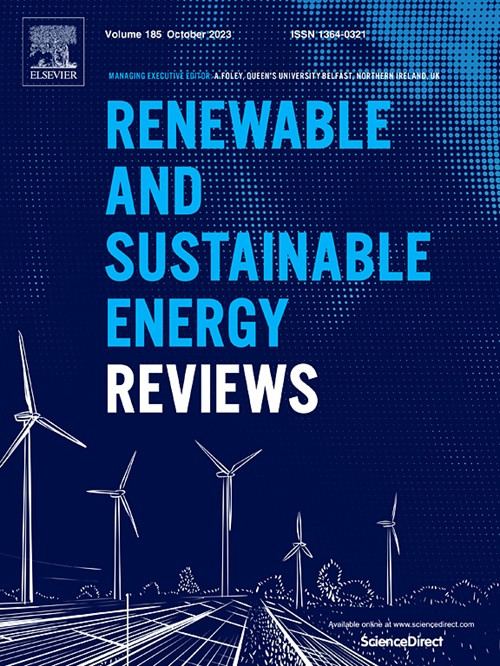Effect of various motion modes on the performance of a floating pneumatic wave energy converter with a backward bent duct
IF 16.3
1区 工程技术
Q1 ENERGY & FUELS
引用次数: 0
Abstract
A floating pneumatic wave energy conversion device with a backward bent duct has six degrees of freedom (DOF) motion, each of which may have different effects on wave energy conversion efficiency. To understand the contribution of each DOF motion to the capture width ratio (CWR), this study explored the impact of nine distinct motion modes on the CWR, including fixed mode; 1-DOF motion modes of surge, heave, and pitch; pairwise combinations of these 1-DOF motion modes; 3-DOF mode (surge, heave, and pitch), and 6-DOF mode (surge, heave, pitch, sway, roll, and yaw), based on Reynolds Averaged Navier-Stokes (RANS) equations. The results revealed the following: (1) The CWRs were essentially equal in both the 3-DOF and 6-DOF modes, suggesting that the influence of yaw, roll, and sway on the CWRs is very small and can be ignored. (2) As the wave period increases from a short period of 4 s to a long period of 9 s, the main contributor to energy conversion gradually shifts from surge motion to heave motion. (3) Different motions can also affect the motion characteristics of other degrees of freedom. This study provides an understanding of the contribution and influence mechanism of different single degrees of freedom and different combinations of single degrees of freedom on the energy conversion and motion characteristics of a floating pneumatic wave energy converter, laying a foundation for further optimization of the converter.
不同运动方式对后弯风道浮式气动波能转换器性能的影响
具有后向弯曲风道的浮式气动波能转换装置具有6个运动自由度,每个运动自由度对波能转换效率的影响可能不同。为了了解各自由度运动对捕获宽度比(CWR)的贡献,本研究探讨了9种不同运动模式对CWR的影响,包括固定模式;脉动、升沉、俯仰的一自由度运动模式;这些1自由度运动模式的成对组合;基于Reynolds平均Navier-Stokes (RANS)方程的3-DOF模式(浪涌、垂荡和俯仰)和6-DOF模式(浪涌、垂荡、俯仰、摇摆、滚转和偏航)。结果表明:(1)在三自由度和六自由度模式下,横摇、横摇和摇摆对横摇力矩的影响很小,可以忽略不计。(2)随着波浪周期由4 s的短周期增加到9 s的长周期,能量转换的主要贡献者逐渐由浪涌运动转向升沉运动。(3)不同的运动也会影响其他自由度的运动特性。本研究了解了不同单自由度和不同单自由度组合对浮式气动波能转换器能量转换和运动特性的贡献及影响机理,为进一步优化转换器奠定了基础。
本文章由计算机程序翻译,如有差异,请以英文原文为准。
求助全文
约1分钟内获得全文
求助全文
来源期刊

Renewable and Sustainable Energy Reviews
工程技术-能源与燃料
CiteScore
31.20
自引率
5.70%
发文量
1055
审稿时长
62 days
期刊介绍:
The mission of Renewable and Sustainable Energy Reviews is to disseminate the most compelling and pertinent critical insights in renewable and sustainable energy, fostering collaboration among the research community, private sector, and policy and decision makers. The journal aims to exchange challenges, solutions, innovative concepts, and technologies, contributing to sustainable development, the transition to a low-carbon future, and the attainment of emissions targets outlined by the United Nations Framework Convention on Climate Change.
Renewable and Sustainable Energy Reviews publishes a diverse range of content, including review papers, original research, case studies, and analyses of new technologies, all featuring a substantial review component such as critique, comparison, or analysis. Introducing a distinctive paper type, Expert Insights, the journal presents commissioned mini-reviews authored by field leaders, addressing topics of significant interest. Case studies undergo consideration only if they showcase the work's applicability to other regions or contribute valuable insights to the broader field of renewable and sustainable energy. Notably, a bibliographic or literature review lacking critical analysis is deemed unsuitable for publication.
 求助内容:
求助内容: 应助结果提醒方式:
应助结果提醒方式:


